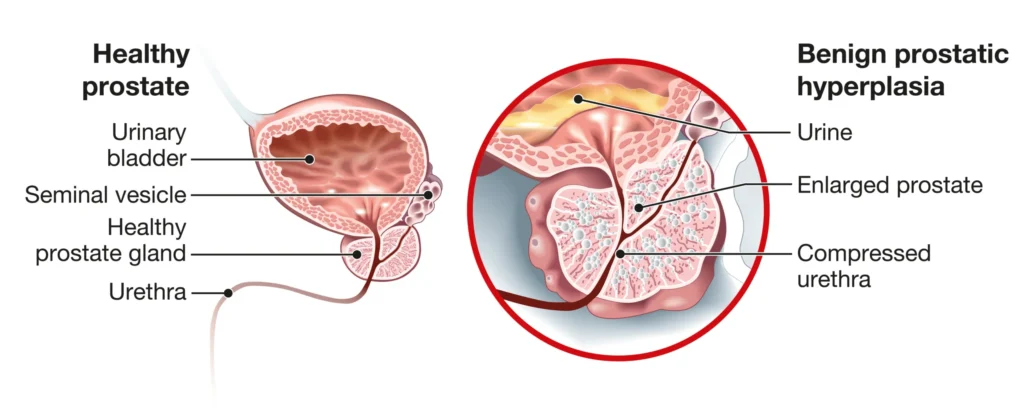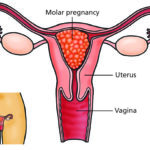Benign Prostatic Hyperplasia (BPH) is a non-cancerous enlargement of the prostate gland, a common condition affecting men as they age. Although BPH is not life-threatening, it can lead to a range of urinary symptoms that significantly impact a person’s quality of life. In this comprehensive guide, we will explore the causes, symptoms, risk factors, diagnosis, treatment options, and preventive measures for BPH. This article aims to provide all the necessary information to help individuals understand and manage this condition effectively.

What is Benign Prostatic Hyperplasia (BPH)?
Benign Prostatic Hyperplasia refers to the enlargement of the prostate gland, a walnut-sized organ located just below the bladder and in front of the rectum. The prostate surrounds the urethra, the tube through which urine is excreted from the body. As the prostate grows larger, it can squeeze the urethra, leading to various urinary symptoms. Despite its name, “benign” indicates that BPH is not related to cancer, but it can still cause complications if left untreated.
Causes and Risk Factors of BPH
BPH typically occurs due to hormonal changes as men age. The primary causes and risk factors include:
Hormonal Changes with Age
As men get older, the balance of hormones like testosterone and dihydrotestosterone (DHT) changes. These hormonal shifts lead to an increase in prostate tissue growth, causing the gland to enlarge. The exact mechanism behind the hormone changes and prostate growth is still under research.
Age
The primary risk factor for developing BPH is age. It is uncommon for men under the age of 40 to experience prostate enlargement, but by the age of 60, more than half of men will show signs of BPH. The condition becomes even more prevalent as men enter their 70s and 80s.
Family History
A family history of BPH or other prostate-related issues increases the likelihood of developing the condition. Men with a close relative who has had BPH may be more prone to experiencing it themselves.
Lifestyle Factors
Certain lifestyle factors, such as obesity, lack of physical activity, and poor diet, have been linked to an increased risk of developing BPH. Additionally, men who consume alcohol or caffeine in excess may experience more severe urinary symptoms.
Symptoms of BPH
The symptoms of BPH primarily affect urination, and the severity can vary from person to person. Common symptoms include:
Frequent Urination
One of the most common symptoms is the frequent urge to urinate, especially during the night (nocturia). This can disrupt sleep patterns and lead to fatigue.
Weak Urine Stream
Men with BPH may notice a decrease in the force of their urine stream, making it harder to empty the bladder completely.
Difficulty Starting Urination
A sense of urgency or difficulty in initiating urination, despite feeling the need to go, is common in men with BPH.
Incomplete Bladder Emptying
After urinating, some men may feel as though their bladder is still full, leading to frequent trips to the restroom.
Dribbling After Urination
A feeling of residual dribbling after urination is another symptom of BPH that can cause frustration and embarrassment.
Urinary Retention
In severe cases, BPH can cause urinary retention, where the bladder is unable to empty entirely. This condition can lead to acute urinary retention, which is a medical emergency.
Diagnosis of BPH
If you are experiencing symptoms of BPH, it is important to consult a healthcare professional for diagnosis. The diagnostic process typically includes:
Medical History and Symptom Review
A doctor will ask about symptoms, their duration, and severity. Understanding your medical history, including any family history of prostate issues, is also crucial.
Physical Examination
A physical exam may include a digital rectal exam (DRE), where the doctor examines the size and consistency of the prostate gland. This exam helps to rule out other conditions such as prostate cancer.
Urinalysis
A urine test may be performed to check for infections or other abnormalities that may be contributing to urinary symptoms.
Prostate-Specific Antigen (PSA) Test
While PSA levels are often elevated in men with prostate cancer, the PSA test can help assess the prostate’s health and identify any potential problems.
Ultrasound and Urodynamic Testing
In some cases, imaging tests such as ultrasound or urodynamic testing may be used to examine the size of the prostate and the function of the bladder.
Treatment Options for BPH
There are various treatment options available for managing BPH. The appropriate treatment depends on the severity of symptoms, overall health, and personal preferences.
Medications for BPH
- Alpha Blockers
Alpha blockers such as tamsulosin help relax the muscles around the prostate and bladder neck, making it easier to urinate. These medications are often used for mild to moderate symptoms. - 5-Alpha-Reductase Inhibitors
These medications, including finasteride and dutasteride, work by reducing the size of the prostate gland. They are particularly effective for men with larger prostates. - Combination Therapy
In some cases, a combination of alpha blockers and 5-alpha-reductase inhibitors may be recommended for better symptom control.
Minimally Invasive Procedures
For men who do not respond to medication, minimally invasive procedures may be considered:
- Transurethral Resection of the Prostate (TURP)
TURP involves removing a portion of the prostate to relieve pressure on the urethra. It is one of the most common surgical procedures for BPH. - Laser Therapy
Laser treatments, such as Holmium Laser Enucleation of the Prostate (HoLEP), use high-energy lasers to remove excess prostate tissue. - Urolift
Urolift is a procedure where small implants are placed to lift and hold the prostate tissue away from the urethra, improving urine flow.
Surgery
For severe cases where other treatments have not been effective, prostate surgery may be recommended. A prostatectomy involves the removal of the prostate tissue, which can be done through various surgical techniques.
Preventive Measures for BPH
While BPH is primarily influenced by age and genetics, adopting certain lifestyle habits can help reduce the risk and severity of symptoms:
- Maintain a Healthy Weight: Obesity is a significant risk factor for BPH, so maintaining a healthy weight through diet and exercise is essential.
- Exercise Regularly: Regular physical activity can improve overall health and reduce the risk of prostate enlargement.
- Limit Caffeine and Alcohol: Both caffeine and alcohol can irritate the bladder and exacerbate urinary symptoms.
- Stay Hydrated: Drinking enough water can help maintain bladder health, but it is also important to avoid excessive fluid intake before bedtime to reduce nocturia.
- Dietary Adjustments: A diet rich in fruits, vegetables, and healthy fats, such as omega-3 fatty acids, may help promote prostate health.

